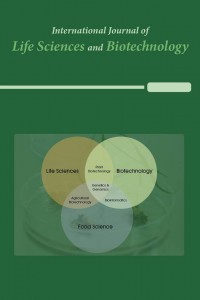Isolation of bacteria from Tuz Gölü lake that can grow on high salt concentration
Isolation of bacteria from Tuz Gölü lake that can grow on high salt concentration
Halophile, halotolerant bacteria, tuz gölu,
___
- Camur, M. Z., and Mutlu, H., Major-ion geochemistry and mineralogy of the Salt Lake (Tuz Gölü) basin, Turkey. Chemical Geology, 1996.127(4): p. 313-329.
- Dumorné, K., Córdova, D. C., Astorga-Eló, M., and Renganathan, P., Extremozymes: a potential source for industrial applications. Journal Microbiol Biotechnol, 2017. 27(4): p.649-659.
- Edbeib, M. F., Wahab, R. A., Kaya, Y., and Huyop, F., In silico characterization of a novel dehalogenase (DehHX) from the halophile Pseudomonas halophila HX isolated from Tuz Gölü Lake, Turkey: insights into a hypersaline-adapted dehalogenase. Annals of Microbiology, 2017. 67(5): p. 371-382.
- Hareland, W. A., Crawford, R. L., Chapman, P. J., and Dagley, S., Metabolic function and properties of 4-hydroxyphenylacetic acid 1-hydroxylase from Pseudomonas acidovorans. Journal of Bacteriology, 1975. 121(1), 272-285.
- Huston, A. L., Krieger-Brockett, B. B., & Deming, J. W., Remarkably low temperature optima for extracellular enzyme activity from Arctic bacteria and sea ice. Environmental microbiology, 2000. 2(4), 383-388.
- Ma, Y., Galinski, E. A., Grant, W. D., Oren, A., and Ventosa, A., Halophiles 2010: life in saline environments. In: Am Soc Microbiol., 2010.
- Mir, S. I., Gasim, M. B., Rahim, S. A., and Toriman, M. E., Soil loss assessment in the Tasik Chini catchment, Pahang, Malaysia., 2010.
- Mutlu, M. B., Martínez-García, M., Santos, F., Peña, A., Guven, K., & Antón, J., Prokaryotic diversity in Tuz Lake, a hypersaline environment in Inland Turkey. FEMS microbiology ecology, 2008. 65(3), 474-483
- Ollivier, B., Caumette, P., Garcia, J.-L., & Mah, R., Anaerobic bacteria from hypersaline environments. Microbiology and Molecular Biology Reviews, 1994. 58(1), 27-38.
- Paul, V. G., & Mormile, M. R., A case for the protection of saline and hypersaline environments: a microbiological perspective. FEMS microbiology ecology,2017. 93(8).
- Sorokin, D. Y., Tourova, T., Galinski, E., Belloch, C., & Tindall, B., Extremely halophilic denitrifying bacteria from hypersaline inland lakes, Halovibrio denitrificans sp. nov. and Halospina denitrificans gen. nov., sp. nov., and evidence that the genus name Halovibrio Fendrich 1989 with the type species Halovibrio variabilis should be associated with DSM 3050. International journal of systematic and evolutionary microbiology, 2006.56(2), 379-388.
- Yayın Aralığı: Yılda 3 Sayı
- Başlangıç: 2018
- Yayıncı: International Society of Academicians
Alpha S1-Casein Gene Polymorphısm in Nigerian Balami Sheep Breed Indigenous to Mubi
İsmaila Yada SUDİ, Mohammed SHUAİBU, Malachi Albert TİZHE
Plants as Potential Repellent Against Oryzaephilus Species
Nurul Huda ABDUL, Nor Hafizah ZAKARİA, Maizatul Akma IBRAHİM
Isolation of bacteria from Tuz Gölü lake that can grow on high salt concentration
Jyng Sheng TEE, Yilmaz KAYA, Fahrul Zaman HUYOP
Bolu ve Tokat İllerindeki Buğday Sap Atıklarının Enerji Potansiyel Değerlerinin Teorik Analizi
Muhammed TAŞOVA, İsmail NANELİ
A Review of Approaches in Steviol Glycosides Synthesis
Nurul Hidayah SAMSULRİZAL, Zarina ZAİNUDDİN, Abdul Latif NOH, Tamil Chelvan SUNDRAM
Fitoöstrojenik Bitkiler; Ne Kadar Tüketilmeli?
Rabia Vildan SOLDAMLI, Sahane Funda ARSLANOGLU
Fusarium culmorum ile Enfekte Edilen Arpa Çeşitlerinde WRKY Transkripsiyon Faktörlerinin Analizi
Ebru ULUHAN, Esra Nur KELEŞ, Feyza TUFAN
Effects of Potato Virus Y Strains on Local Tomato Genotype “Sazlıca”
Musadik Abdullahi AHMED, Eminur ELÇİ
Narayan KHATRİ, Bisheshwor Prasad PANDEY, Mamata BİSTA, Dev Lakshmi GHİMİRE
